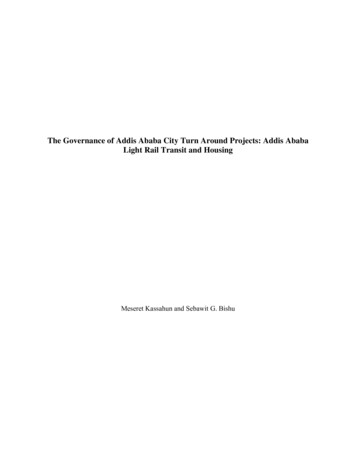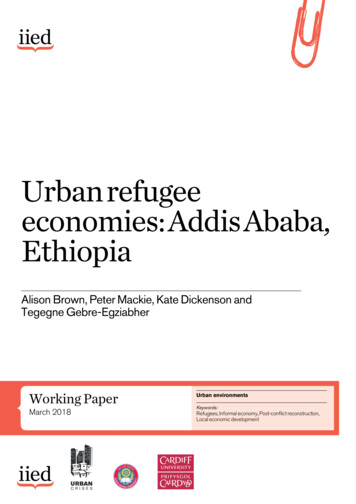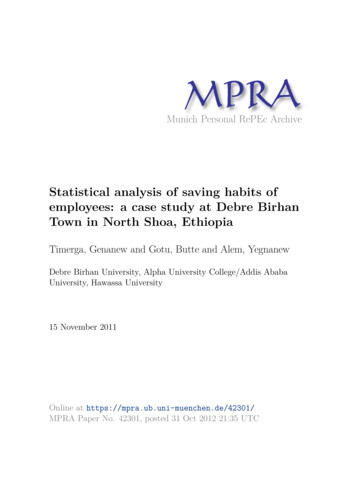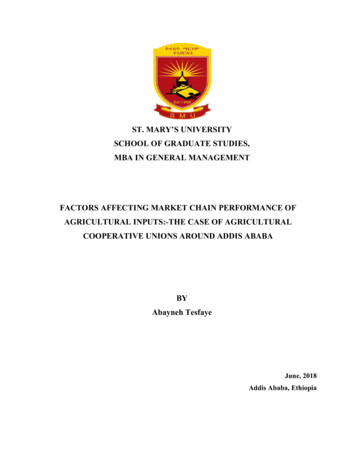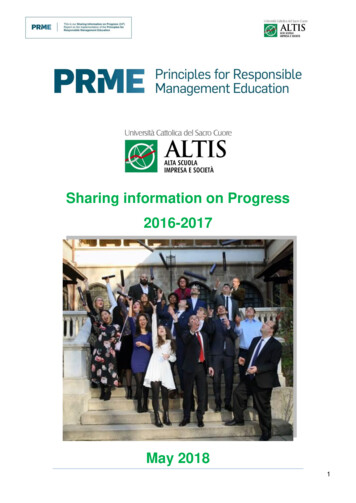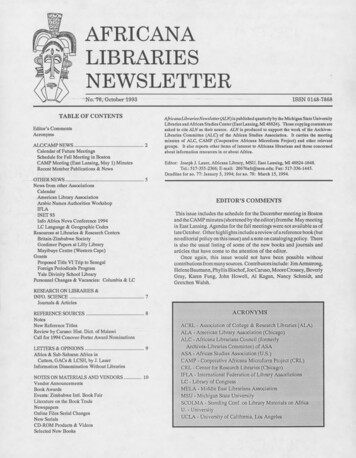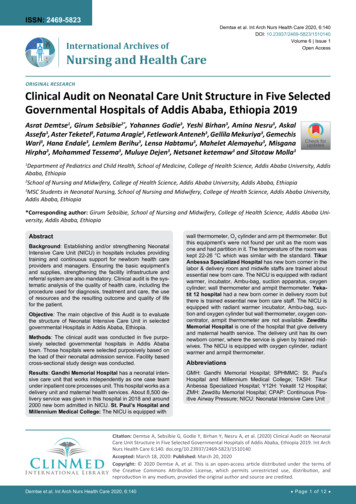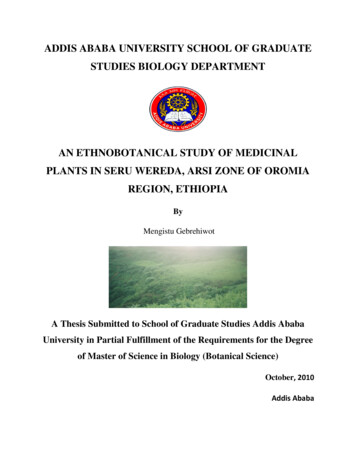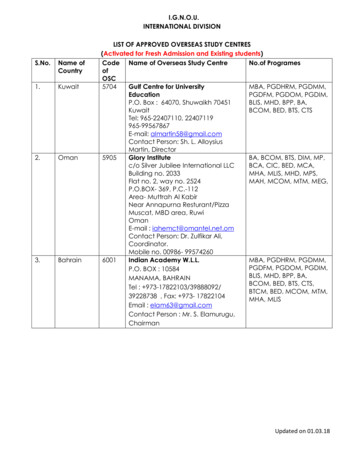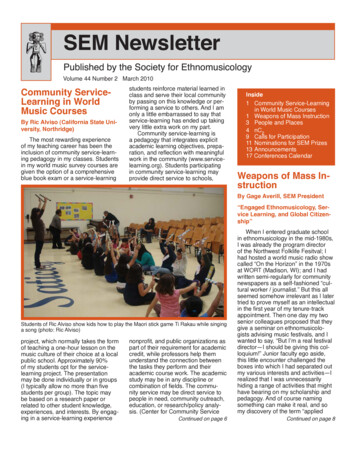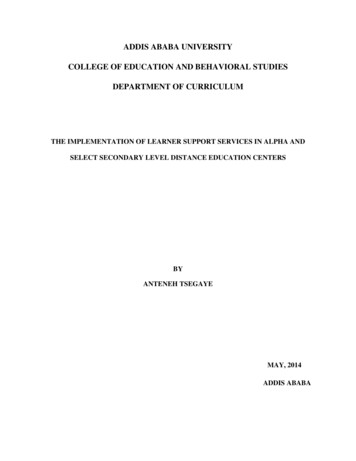
Transcription
ADDIS ABABA UNIVERSITYCOLLEGE OF EDUCATION AND BEHAVIORAL STUDIESDEPARTMENT OF CURRICULUMTHE IMPLEMENTATION OF LEARNER SUPPORT SERVICES IN ALPHA ANDSELECT SECONDARY LEVEL DISTANCE EDUCATION CENTERSBYANTENEH TSEGAYEMAY, 2014ADDIS ABABA
THE IMPLEMENTATION OF LEARNER SUPPORT SERVICES IN ALPHA ANDSELECT SECONDARY LEVEL DISTANCE EDUCATION CENTERSBYANTENEH TSEGAYEADVISORGETACHEW ADUGNAMAY, 2014ADDIS ABABA, ETHIOPIAADDIS ABABA UNIVERSITY
Addis Ababa UniversitySchool of Graduate StudiesThis is to certify that the thesis prepared by Anteneh Tsegaye entitled: The Implementation ofLearner Support Services in Alpha and Select Secondary Level Distance Education Centers andsubmitted in partial fulfillment of the requirements for the degree of Masters of Arts (Adult andlifelong learning) complies with the regulations of the University and meets the acceptedstandards with respect to originality and quality.Signed by the Examining committee:External ExaminerName Signature DateInternal ExaminerName Signature DateAdvisorName Signature DateChair of Department of Graduate program coordinator
AcknowledgementsI would like to express my heartfelt gratitude to my advisor Dr. Getachew Adugna for hisunreserved professional guidance as well as continuous and untiring help.He has closelyfollowed the progress of my work, reviewing the various drafts and offering numerouscomments and suggestions. His timely, meticulous and constructive comments had transferredthe original draft of the research report, hopefully into an academically acceptable thesis. Inshort, the study would not have come out in its present form without his invaluable commentsand suggestions.I am greatly indebted and grateful to Ato Gashaw Eshetu, Ato Kiflu Hassen and Ato BerhanuAssefa for their continuous support and encouragement, besides their willingness to provide mewith their private reference books, which were invaluable to my work.My heart-felt appreciation and thanks must extended to W/o Tewabech Berehe for herconsiderate and kind cooperation in writing questionnaires and drafts of the study in thecomputer.I am grateful to Frezer Gidey, Ruth Masebo and Mikyas Yekuno for they have supported meduring the entire period of my study, and for their dedication in gathering and tabulating the data.I would like to express my appreciation to my wife W/O Bisrat Mulualem, my child ElnathanAnteneh for their encouragement, support and patience, while I was working on the study.At last, I am also very much indebted to the Ato Adehana Girmye and Ato Mulugeta Deressa;Administration head, Ato Ephrem Fetene and Ato Dereje Tefera; coordinators, Addis Abababranch for their hospitality and cooperation.i
Table of contentsAcknowledgements .ITable of contents .IIList of Tables .IVList of figure .VList of Acronyms .VIList of Appendices .VIIIAbstract .IXCHAPTER ONE1. INTRODUCTION .11.1 Background of the study .11.2 Statement of the problem .41.3 Significance of the study .61.4 Objectives of the study .71.5 Delimitations of the study .71.6 Limitation of the study .81.7 Definition of the Key Term .81.8 Organization of the study .9CHAPTER TWO2. REVIEW OF RELATED LITERATURE .102.1. Distance education: .102.1.1. The concept of Distance Education .122.1.2. The importance of distance education .132.2. History of Distance Education: World view .142.2.1. Distance education in India .142.2.2. Distance education in USA .172.2.3. Distance education in Turkish .202.2.4. Distance education in Japan .212.2.5. Distance education in Ethiopia .222.3. Support Services .242.3.1. Student Support Services.252.3.2. Administrative two ways communication .282.3.3. Roles of Stakeholders in Support Services .322.4. Conceptual frame work .36CHAPTER THREE3. RESEARCH DESIGN AND METHODOLOGY .373.1. The research design .373.2. The study area .37ii
3.3. Data sources .373.4. Population and sampling techniques .383.5. Data collection instruments and procedure .393.5.1. Questionnaire.393.5.2. Interview .403.5.3. Document analysis .413.5.4. Observation .413.6. Pilot Study .413.7. Methods of Data Analysis .42CHAPTER FOUR4. PRESENTATION, ANALYSIS AND INTERPRETATION OF THE STUDY .434.1. Background information of the respondents .434.2. Results of the data gathered by questionnaire and interview .444.2.1. Issue Related to pre- enrollment services .444.2.2. Issue Related to Convenience of Course material Distribution .474.2.3. Issue Related to Availability and Adequacy of Administrative Services .504.2.4. Issue Related to Tutorial Face to Face Contacts .524.2.5. Issue Related to Library Services .614.2.6. Issue Related to Guidance and Counseling Services .644.2.7. Issue Related to Assignment and Feedback .674.2.8. Issue Related to Exam and Feedback .74CHAPTER FIVE5. SUMMARY ,CONCLUSION AND RECOMMENDATIONS .795.1. Summary .795.2. Conclusion .815.3. Recommendation .82References .85Appendices .9iii
List of TablesTablesPageTable 1 – Characteristics of the respondents .43Table 2 – Learners response related to related to school location .44Table 3 – Learners response related to Presence and type of pre-enrolment services .45Table 4 – Learners responses related to Convenience of Course Material Distribution .47Table 5 – Learners response related to Administrative Support .50Table 6 – Learners response to availability, number, means, adequacy and convenient face toface contacts .52Table 7 – Learners response Related to convenience and duration Tutorial program.56Table 8 – Learners Response to the Availability and Convince of Library.61Table 9 – Learner‘s response to Availability of Guidance and Counseling Services .64Table 10 - Response to number, significant and account to final grade of assignment .67Table 11 - Learners Response to comment and account to final grade of assignment .71Table 12 - Learners Response to Exam schedule, convenience exam and Feedback .74Table 13 - Learners response to time of getting exam paper, comment and re-exam .76iv
FigureFigure 1 - Conceptual frame work of the study .36v
List of AcronymsAACSB - Association to Advance Colligate School of BusinessAECT - The Association for Educational Communications and TechnologyAIDS – Acquired Immune Deficiency SyndromeAIs – Accredited InstitutionsAM – Amplitude ModulationAUC – Alpha University CollegeBA - Bachelor of ArtsBTC- British Tutorial CollegeCOL – Learning Common Wealth of LearningCPB – Corporation for Public Broad CastingDE – Distance EducationEC – Ethiopian CalendarEMA – Ethiopia Media AgencyESLCE – Ethiopia School Learning Certificate ExaminationFM – Frequency ModulationGDECPAA- Guidelines for Distance Education Credit Program Array and ApprovalHIV – Human Immune Deficiency VirusIGNOU - Indira Gandhi National Open UniversityICS- International Correspondence SchoolsMA – Masters of ArtsMDEC – Mandela Distance Education CollegeMOE – Ministry of EducationNFDE- Non Formal Distance EducationNFE- Non- Formal EducationNGO- Non- Governmental Organizationvi
ODL- Open and Distance LearningPADEA – Pan Africa Distance Education AcademyPBS – Public Broad Casting ServicesSMDEC – St. Mary‘s Distance Education CollegeSRS- Students Response SheetsTTC- Trans World Tutorial CollegeTV - TelevisionUHF – Ultra High FrequencyUNDP- United Nation Development programUNESCO - United Nations Educational, Scientific and Cultural OrganizationUNICEF - United Nations Children FundUNISA- University of South AfricaUK- United KingdomUSA – United States of AmericaUSAID - United States Agency for International Developmentvii
List of AppendicesAppendix I- Questionnaire for learners .90Appendix II- Interview Question for Administration .99Appendix III- Interview Question for Program Coordinator .100Appendix IV- Interview Question for Program Tutors.102Appendix V- Document Analysis .103Appendix VI- Observation Checklist.105viii
AbstractThe Implementation of Learner Support Services in Select and AlphaDistance Education Institution.Anteneh TsegayeAddis Ababa University, 2014The purpose of the study was to assess the implementation of learner support services in Selectand Alpha distance education institutions. The study used to descriptive case study method,because it was found convenient to represent existing situation about implementation of learnersupport services. The research included 2 distance education institutions; the study participantswere selected by Probability (simple random sampling) and non probability (purposivesampling). 523 representative respondents composed of 494 learners, 25 tutors and 2coordinators and 2 administrators. Three data gathering tools namely questioners, interview andobservation check list had been employed in order to gather necessary data of the study whichwere composed of close ended and open ended items were applied in the research. The datagathered through interview observation and questionnaire was processed through threeconcurrent flows of activity of the qualitative analysis system which include data reduction, datadisplay and conclusion drawing. The Major findings of this study include delay of modules andlost course materials, less learner’s participation on face to face tutorial program, lack oflibrary, lack of guidance and counseling services and inadequacy of administrative support. Thestudy also found that week follow up, support and feedback system on the assignment andexamination. Lack of training opportunity for tutor and coordinators were the major challenges.For further improvement advanced follow up, support and immediate feed, and fulfillment oflearners support services were suggested as potential solution to the proper implementation oflearners support services.ix
CHAPTER ONE1. INTRODUCTIONThis chapter is concerned with the introductory part of the thesis. It comprises backgroundof the study, the statement of the problem, the significance of the study,objectives of the study,delimitation of the study, limitation of the study, definition of terms, and organization of thestudy.1.1.Background of the StudyEducation is universally recognized as a fundamental building block for humandevelopment and one of the strongest instruments for reducing poverty. It also enablesindividuals and society to make all rounded participation in the development process byacquiring knowledge, ability, skills and attitudes. According to Ethiopian education and trainingpolicy, education enables to strengthen the individuals and society‘s problem solving capacity,ability and culture starting from basic education and at all levels (MOE,1994:1). Education alsohelps a country to create strong and competitive economy, which can effectively cope upwith the challenges of development and can easily and confidently adapt to the changingmarket and technological conditions in the global economy (Hazen cited in Dechassa2010:1)Moreover, education represents the sum total of all the processes of human learning bywhich knowledge, skills and attitudes are gained. In this regard, informal, formal and non-formalare major forms of education. An informal education does not correspond to an organized andsystematic view of education, learning resulting from daily activities related to work, family orleisure, as well as it is not organized or structured in terms of objectives, time or learningsupport. Informal learning is in most cases unintentional from the learner's perspective (Eurydic2011:17). On the other hand, formal education involves a combination of registered enrolmentand work to a syllabus, which leads to some sort of certificate. Formal education characterizedby the following characteristics such as: limited to a period being taught, uses somehow rigidtime table scheduled for various subjects, taught during regular school hours days and months,has a fixed point of entry and exit time and it has fixed concepts and contents in its curricula(Harvey 2007:6). While, non-formal education refers to a systematic learning opportunities that1
are organized outside the framework of the formal system of education, and that are addressingthe learning needs of specific target groups (Befekadu, 2006:2).In this regard, different countries utilize varies types of NFE programs depending onspecific needs and situations. Basically NFE includes: school equivalency programs to provide asecond chance to those who have missed school, training in occupational skills and on the jobtraining such as: agriculture extension and farmer training programs, Adolescence and adultliteracy programs, community education and community programs of instruction in health,nutrition, family planning etc.However, Distance education is categorized under the stream of non-formal education(Claudio 1987:6) and Tesfaye (2002:31) revealed the same issue.Besides, this distanceeducation is an indirect form of education, where the teacher and the students are separated bothphysically and in time span. The teacher‘s transmission of the study materials is separated fromthe student‘s acceptance. The transmitted material between them consists of printed andelectronic media, and those technologies useful for distance education (Medeja, etal 2001:4).In Ethiopia, from early 20th century of Emperor Menelik up to the end of Derg regimedistance education normally referred to as adult education because it is more integrated with lifeand work, and it provides education mostly to the adult population (Karanja 1997:8). Accordingto karanja, in1955, on the Emperor's coronation a national policy was initiated to provide freeand compulsory education to enable illiterate adults aged 50 and above to become involved inteaching adults.Then after, a National Literacy Council was officially established to co-ordinate literacyprograms and the adult literacy project being implemented by UNESCO/UNDP. In 1957, aMinistry of Community Development was established to promote socio-economic development.To support this objective the Ministry of Education, in collaboration with USAID and UNESCO,instituted special teacher education centers at Debre Birhan and Majete to train teachers forelementary and adult education. At the grass roots level, community development agents werecharged with the task of promoting development programs in literacy and numeracy. Theprogram was to be implemented by a team of five men and two women for each woreda2
(district). Trained village level workers from the Awassa Community Development Centre wereassigned to some 20,000 peasants per Development District (Karanja, 1997: 8).However, according to Tesfaye (2002:4) distance education in the form ofcorrespondence education appeared as early as 1967 in private institution. British TutorialCollege (BTC), International Correspondence Schools (ICS) and Trans World Tutorial College(TTC) are some. At that time, non-formal distance education has three primary modes ofdelivery: printed materials; media and brief face-to-face instruction. To date in Ethiopia, aselsewhere in developing countries printed materials remain the most common mode of deliveryand are much more familiar with students of NFDE.Then after, since the change of government in 1991, Ethiopia has undergone extensivechange of the country‘s political ideology grounded in federalism and democratization. Some ofthe changes have had profound implications for distance education in Ethiopia.Now a day, in both governmental and private of distance education the provision mainlyfocuses on in different levels and programs such as 2nd cycle primary education (5-8), secondaryeducation 1st cycle (9-10) and 2nd cycle (11-12), degree and MA programs in government andprivate centers, institutions, colleges and universities. Print materials, educational Radioprograms, as one of the instructional components. Face-to Face tutorial programs, processinggrade reports, managing technical services, enrolling new students, recording information,counseling, giving and correcting exams and assignments are needed as support services. Theabove support services play an important role to maintain the quality of distance education in anylevel.In addition, according to Guidelines for Distance Education Credit Program Array andApproval (GDECPAA) (2000:1-4) the quality of distance education mainly depends on thequality of curriculum and instruction, evaluation and assessment, library and learning resources,student services, and facilities and finances of the institution. Therefore, the main purpose of thisresearch is assessing the implementation of learners support services.3
1.2.Statement of the problem.Today, it is realized that human resource development at all levels, as aprecondition for economic growth and development. Human resource development requiresprovision of education especially quality education to any citizens that are found at any levels.According to UNICEF (2000: 4) quality education includes learners (healthy, well nourished andready to participate and learn), environments (healthy, safe, protective, gender-sensitive, andprovide adequate resources and facilities), content (relevant curricula and materials), trainedteachers (used different teaching approaches and well-managed classrooms) and out comes(encompass knowledge, skills and attitudes).The above quality indicators stated by UNICEF show that during the provision andimplementation of education there must be given much attention. In most cases, some of thesesuch as healthy, well-nourished learners and environments that are healthy, safe, protective andgender-sensitive are not considered as the quality indicators.On the other hand, learning can occur anywhere, but the positive learning outcomesgenerally sought by educational systems happen in quality learning environments. Learningenvironments are made up of physical (includes quality of school facilities, interaction betweenschool infrastructure and other quality dimensions, class size), psychosocial (includes Peaceful,safe environments, especially for girls, Teachers‘ behaviors that affect safety, effective schooldiscipline policies, inclusive environments and non-violence) and service delivery elements(includes Provision of health services) UNICEF (2000:7-10). Based on the above assumption,distance education is one part of non-formal education so; it needs the above quality learningenvironments such as physical, psychosocial and service delivery elements.Distance learning has become a worldwide and growing phenomenon AACSB (2007:3)because of technology. The innovative use of technologies creates effective techniques todistribute learning in non-traditional ways. As a result, new organizational structures andlearning arrangements are appearing throughout institutions.In Ethiopia, distance education, one of the modes of delivery advocated by internationaleducation movements, is now gaining momentum. One instance of such momentum of distance4
education in Ethiopia is the recently involvement of privet institution in providing secondaryeducation using distance mode.It is obvious that such private secondary distance education involvement in contributes tosolve educational problems associated with the development and expansion of higher educationin the country. In addition to this secondary distance, learning offers a number of advantages toboth learners and to providers of opportunities for learning Problems such as distance and time,implementation of learners supportive services are barriers to conventional learning, areovercome in distance learning.However, the secondary distance education faces different challenges personally andinstitutionally. For instance, personal, challenges include difficulties organizing studies andfinding sufficient time to study, difficulties balancing work, and family commitments. On theother hand, institutionally challenges includes lack of well-developed student support servicessuch as face-to-face contact, libraries with the institution, lack of administrative , guidance andcounseling supports and difficulties receiving feedback on assignments that is timely and useful.Quality in distance education is one of the main concerns among institutions. As I mention inthe introductory part quality of distance education depend on the quality of curriculum andinstruction, evaluation and assessment, library and learning resources, student support services,facilities and finance of the institution. From these quality indicators students support servicesare one of the main quality issues. A student support service refers to a variety of academic andnon-academic interactions that the student has with a college or institutions (Floyd and Powell,2004: 56).Floyd and Powell (2004: 56) Salih (2004:2) and Parimal and Manoj (undated: 6) revealedthe same issue regarding on student support services.According to them student supportservices include: pre enrollment services (recruiting, promotion, and orientation),admissions andregistration, academic advising, financial planning and management, library and bookstoreservices, academic and career counseling, social support services, certificate and transcriptauditing, and technical support. Alpha and Select distance education centers are one of the wellknown distance education centers in Ethiopia. They are organizations, which are directlyinvolved in helping distance learners. In order to accomplish their goal the implementation of5
learners support services are important. The primary purpose of this study was assessing theimplimentation of learners support services.In order to achieve general and specific objectives the study attempts to answer thefollowing basic questions:1. What learner support systems do the two institutions provide to their learners?2. To what extent the two institutions implement student support services.3. Are the students having awareness about student supportive services?4. To what extent the student support services of the institutions convenient to their learners.1.3 Significances of the studyExperience and research so far show that distance learning, like any kind of learning, canserve different ends, but distance learning appears mainly to serve those who cannot or do notwant to make use of classroom . Therefore, it can be instrumental only if its organization,management system and student support services are so efficient and effective. In view of thisfact, the investigation of the existing problems related to quality of implementation andinstructional media development and distribution; media utilization, communication, face-to-faceprograms, training etc. are essential not only for the beneficiaries but also for the effectivefunctioning of tutors, counselors, course writers, editors, designers, radio program producers andothers. As far as the researcher is concerned, no scholarly work is done on quality of studentsupport services at secondary level (9-10) of Ethiopia.Therefore, this study is hoped to be useful in examining the weaknesses and strengths ofthe two selected types of institutions with regard to the implimentation of student supportservices. Specifically, the study: Provides information to policy makers and distance education curriculum developers onthe quality of student support services in Ethiopia in general and in the selectedinstitutions in particular;6
Helps distance education providing institutions under study identify their strengths andweaknesses so that they can make adjustments and improvements of their distanceeducation programs in the future; Enables other distance education providing institutions learn from the weaknesses andstrengths of studied institutions there by adjusting and improving their own distanceprograms; The findings of this study may also serve as a springboard to other researchers, forfurther investigations in the area.1.4. Objectives of the studyThe general objective of this study was to assessing the implementation of learnerssupport services in Select and Alpha distance education centers wh
Addis Ababa University School of Graduate Studies This is to certify that the thesis prepared by Anteneh Tsegaye entitled: The Implementation of Learner Support Services in Alpha and Select Secondary Level Distance Education Centers and submitted in partial fulfillment of the requirements for the degree of Masters of Arts (Adult and

